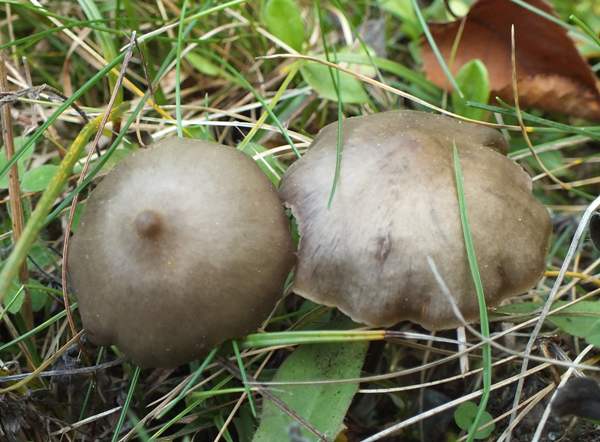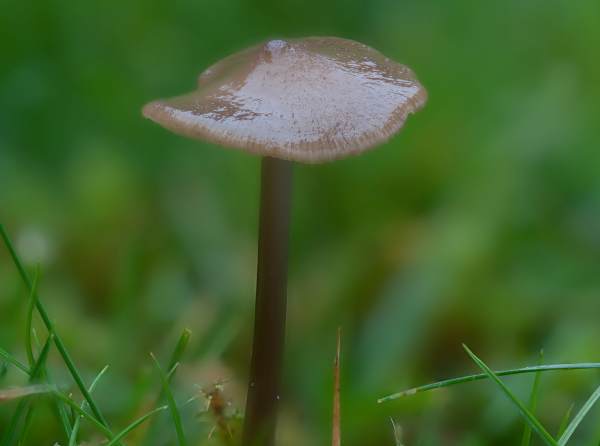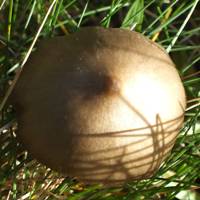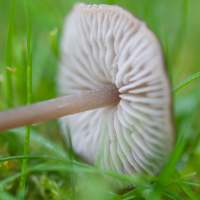Entoloma papillatum (Bres.) Dennis - Papillate Pinkgill
Phylum: Basidiomycota - Class: Agaricomycetes - Order: Agaricales - Family: Entolomataceae
Distribution - Taxonomic History - Etymology - Identification - Culinary Notes - Reference Sources

Despite its scientific and common names, Entoloma papillatum is by no means the only 'papillate' (with a nipple-like raised projection in the centre of its cap) pinkgill. For this reason it is not a species that many people will ever be able to identify with confidence in the field.
The specimens shown in the shown on this page have been independently verified by microscopic examination of spores and of samples of gill and cap tissue.

Distribution
The Papillate Pinkgill is an uncommon to rare find in Britain and Ireland; it occurs throughout mainland Europe, where it is also quite rare.
Taxonomic history
This uncommon mushroom was described scientifically in 1887 by the Italian mycologist Giacopo Bresadola (1847 - 1929), who gave it the name Nolanea papillata.
It was the British mycologist Richard William George Dennis (1910 - 2003) who, in 1953, transferred this species to its current genus, at which point its binomial scientific name became Entoloma papillatum.
Synonyms of Entoloma papillatum include Nolonea papillata Bres., Nolanea mammosa ssp. papillata (Bres.) Konrad & Maubl., and Rhodophyllus papillatus (Bres.) J. E. Lange.
Etymology
The generic name Entoloma comes from ancient Greek words entos, meaning inner, and lóma, meaning a fringe or a hem. It is a reference to the inrolled margins of many of the mushrooms in this genus.
The specific epithet papillatum means papillate - having a small nipple-like projection. (In mammals, the nipples of the mammary glands are known as papillae.)
Identification guide
 |
Cap0.5 to 4cm across; initially conical, becoming broadly convex with a small nipple-like umbo; not hygrophanous; reddish brown with a darker brown centre, gradually becoming violaceous brown with age; surface smooth and translucently striate. |
 |
GillsModerately spaced, emarginate and almost free; greyish brown at first, maturing brownish pink. Stem2 to 7cm long and 1 to 3mm diameter, smooth, cylindrical; reddish brown; no stem ring. |
SporesMostly five- to seven-angled (pentagonal to hexagonal) in side view; 9-13 x 6.5-8.5μm. Spore printBrownish pink. |
|
Odour/taste |
Slightly mealy (farinaceous) but not distinctive. |
Habitat & Ecological role |
Saprobic in unimproved grassland, mainly but not solely on calcareous soil. |
Season |
Fruiting from summer to late autumn in Britain and Ireland. |
Similar species |
|
Culinary Notes
Entoloma papillatum is too rare to be collected for anything but essential research. (It is also thin-fleshed and insubstantial.)
Reference Sources
Fascinated by Fungi, 2nd Edition, Pat O'Reilly 2016, reprinted by Coch-y-bonddu Books in 2022.
Studies in the genus Entoloma (Basidiomycota, Agaricales) from the Kiklades (C. Aegean, Greece), Machiel Noordeloos & Elias Polemis; Mycotaxon, Volume 105, pp. 301–312 July–September 2008.
Knudsen H., Vesterholt J. (eds) Funga Nordica: agaricoid, boletoid and cyphelloid genera - Nordsvamp, 2008
Dictionary of the Fungi; Paul M. Kirk, Paul F. Cannon, David W. Minter and J. A. Stalpers; CABI, 2008
Taxonomic history and synonym information on these pages is drawn from many sources but in particular from the British Mycological Society's GB Checklist of Fungi.
Acknowledgements
This page includes pictures kindly contributed by David Kelly.
Fascinated by Fungi. Back by popular demand, Pat O'Reilly's best-selling 450-page hardback book is available now. The latest second edition was republished with a sparkling new cover design in September 2022 by Coch-y-Bonddu Books. Full details and copies are available from the publisher's online bookshop...

